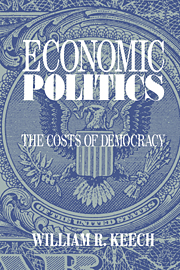Book contents
- Frontmatter
- Contents
- List of figures and tables
- Preface and acknowledgments
- INTRODUCTION
- MODELS OF ROUTINE POLITICS
- 3 Models of Accountability and Opportunism: The Electoral Cycle
- 4 Models of Choice: Partisanship
- THE SOURCES AND AUTHORITY OF MACROECONOMIC GOALS
- INSTITUTIONS AND PROCESSES
- CONCLUSION
- References
- Index
3 - Models of Accountability and Opportunism: The Electoral Cycle
Published online by Cambridge University Press: 05 June 2012
- Frontmatter
- Contents
- List of figures and tables
- Preface and acknowledgments
- INTRODUCTION
- MODELS OF ROUTINE POLITICS
- 3 Models of Accountability and Opportunism: The Electoral Cycle
- 4 Models of Choice: Partisanship
- THE SOURCES AND AUTHORITY OF MACROECONOMIC GOALS
- INSTITUTIONS AND PROCESSES
- CONCLUSION
- References
- Index
Summary
This is the first of two chapters that review the two most prominent models or theories of politics in macroeconomic policymaking: the electoral-cycle theory and the partisanship theory. These theories each capture special features of democratic politics and help us to understand democratic dynamics. In doing so, they abstract from the institutional details through which economic policy is made. Each leaves a great deal about macroeconomic politics unexamined and unexplained. The electoral-cycle model focuses on periodic elections as the democratic institution of interest, and the partisanship model focuses on dual alternatives in these elections. Both types of models connect these features of focal interest to macroeconomic outcomes: unemployment, income growth, and sometimes inflation.
In the real world, the impacts of elections and party differences are mediated through complex institutional structures of fiscal and monetary policies. For example, most of the contemporary models to be considered in these two chapters presume that governments influence macroeconomic performance through monetary policy, that is, through government control of the money supply and interest rates. Monetary policy is controlled by central banks, such as the U.S. Federal Reserve System (“the Fed”). Electoral-cycle and partisanship models often assume that the Fed obediently follows the preferences of politically motivated public officials. In fact, the Fed is considered to be one of the most politically independent of the central banks in the industrialized nations.
- Type
- Chapter
- Information
- Economic PoliticsThe Costs of Democracy, pp. 47 - 65Publisher: Cambridge University PressPrint publication year: 1995



